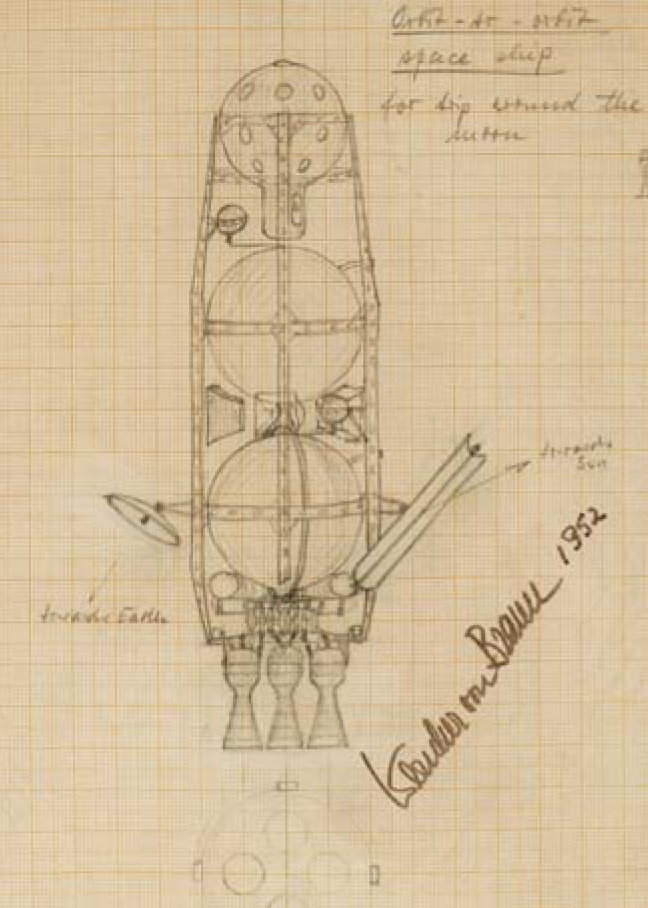Von Braun spaceflight dreams auctioned
DOI: 10.1063/1.3047669
”Once the rockets are up, who cares where they come down
That’s not my department,” says Wernher von Braun
—Tom Lehrer
In an October auction, sketches, diagrams, and letters by rocket scientist Wernher von Braun fetched $132 000, far more than the $10 000–$25 000 anticipated. “The whole field of collecting 20th-century scientists and especially physicists has really exploded,” says Catherine Williamson, director of fine books and manuscripts at Bonhams, the international auctioneer that sold the von Braun lot.
As technical director of the German liquid-fuel rocket program under Adolf Hitler, von Braun was responsible for the V-2 rocket, which was fired on London, Antwerp, and other cities in 1944 and 1945. At the end of the war, von Braun, with more than 100 members of his Third Reich rocket team and many other Nazi scientists and engineers, was brought to the US as part of the military’s secret Operation Paperclip. He became a central figure in the US rocket program.
Although he had worked mostly on weapons, von Braun had a passion for space travel. The 35 documents in the recently sold lot were guidelines for color illustrations to accompany the “Man Will Conquer Space Soon!” series published in Collier’s Weekly in 1952–54. Spaceships, a space station, a satellite, Moon rovers, equipment for a lunar base, and banks of computers were among the detailed drawings and freehand sketches auctioned. The letters were to the Collier’s editor in charge of the series.
“The series was incredibly influential,” says Williamson. “This was the moment when [von Braun] was able to make the argument to the American public and, by extension, Congress. The series turned [the idea of manned spaceflight] from science-fiction fantasy to probable and possible with enough money and time.”
The Collier’s series “was very important in selling the public on space flight,” agrees Mike Neufeld, chair of the Smithsonian Institution’s National Air and Space Museum’s space history division. Von Braun “presented a whole vision—everything from the basic rocket vehicles to space stations to going to the Moon and going to Mars. And the series presented it in a way that was bolstered by von Braun’s scientific reputation. It came at the right time.” But, he adds, similar drawings exist in other places, “and, clearly, a lot of what von Braun envisioned didn’t come to pass in the form predicted.”
As for the lyrics in Tom Lehrer’s song, Neufeld says, “it’s too simplistic, but it does nail him to a certain extent.” In his recent biography of von Braun, Neufeld adds, “I depict him as making a Faustian bargain in the Third Reich because of his willingness to work for anyone who paid for work on rockets. He was involved with concentration camp labor. He was a loyal supporter of Hitler. He had no problem with [the Third Reich’s] nationalist aims. He wore the SS uniform. But I found no evidence that he was anti-Semitic. He is a fascinatingly ambiguous case.”
In 1960 von Braun became the founding director of NASA’s Marshall Space Flight Center in Huntsville, Alabama, and in 1969 his dream of landing on the Moon was realized. He died in 1977 at the age of 65.

An “orbit-to-orbit” spaceship for circling the Moon was among the recently auctioned sketches by pioneer rocket scientist Wernher von Braun. The uppermost sphere was divided into five floors and was intended to house crew members.
(Courtesy of Bonhams.)

More about the Authors
Toni Feder. American Center for Physics, One Physics Ellipse, College Park, Maryland 20740-3842 US . tfeder@aip.org





